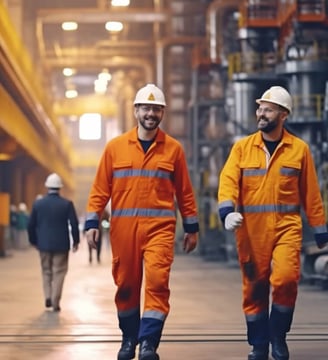Modern industrial security technologies and systems
Blog post description.
الأمن والسلامة والصحة المهنية
1/3/20242 min read
Modern industrial security technologies and systems


Introduction:
The Modern Industrial Safety and Security Systems course aim to provide participants with the knowledge and skills related to modern global industrial safety standards. The course seeks to familiarize participants with international standards, methodologies, instructions, and requirements for their application in institutions. Throughout the course, the importance of a clear understanding of global standards and methodologies in the field of industrial safety will be addressed. Participants will also be introduced to the latest tools and technologies used to integrate these standards with the requirements of safety, health, and environmental regulations in industrial work environments.
By the end of the course, participants are expected to be able to understand and apply the acquired knowledge effectively in managing industrial safety methodologies in their facilities, guided by these modern standards and methodologies.
Course Objectives:
Participants will be able to:
Understand the characteristics and attributes of an industrial safety supervisor.
Grasp concepts of efficiency, effectiveness, and excellence in industrial safety.
Familiarize themselves with the fundamental strategies and international standards of industrial safety.
Identify and evaluate risks in industrial facilities and implement risk management strategies.
Understand technology in occupational safety and health in the workplace.
Explore the causes of accidents, control methods, and mitigation strategies.
Learn modern scientific methods to reduce losses in industrial facilities.
Implement gradual risk control strategies (hierarchical pyramid).
Understand ideal industrial environmental standards.
Training Methodology:
The training methodology in the Advanced Industrial Security Systems and General Safety Standards course relies on practical and applied interaction, ensuring participants gain a deep understanding and practical application skills. The course includes a mix of theoretical lectures supported by real-world examples, interactive workshops using case studies for real-life scenarios, brainstorming sessions, and group discussions aimed at exchanging experiences among participants. Practical exercises focusing on the application of industrial safety standards are included, emphasizing the importance of compliance with safety procedures according to local and international standards.
Target Audience:
This training is designed to be beneficial for all elements of industrial safety involved in developing safety and occupational health programs. This includes safety managers, engineers, industrial safety supervisors, monitors, quality auditors, technicians, and workers in high-risk industrial areas.
Program Content:
Industrial Safety Management and Workplace Environmental Risk Assessment:
- Concept of health and safety in the workplace.
- Responsibilities of an industrial safety supervisor.
- Work-related accidents and diseases (concept, causes).
- Sources and causes of work-related accidents and diseases.
- Risk assessment in the industrial work environment.
Rules and Guidelines for Safety in the Industrial Work Environment:
- Safety instructions and guidelines for laboratories.
- Safety instructions and guidelines for workshops.
- Safety instructions and guidelines for warehouses.
- Periodic review, evaluation, and modification of safety instructions.
- Safe working methods for all activities in the industrial facility.
Fire Prevention in the Industrial Work Environment:
- Preparation and leadership of industrial firefighting teams.
- Control systems and automatic fire alarms.
- Ionization, optical, linear, flame, and smoke detectors.
- Fire alarm systems (ordinary and addressable systems).
- Modern gas fire extinguishing systems (FM 200, Novac, Nitrogen).
Supervision and Organization of Important Industrial Installations for Risk Prevention:
- Site requirements and building constructions.
- Safe electrical installations and backup power generators.
- Ventilation, lighting, leakage drainage, exits, and passages.
- Personal protective equipment (usage, maintenance, and storage).
- Model for the storage and disposal of homogeneous and non-homogeneous chemical materials.
Elements of Emergency Plans in Industrial Environments:
- Required procedures and available resources.
- Detailed list of individuals, their tasks, and responsibilities.
- Escape routes, assembly points, and service locations.
- Authorities for partial and complete evacuation and the completion of the evacuation process.
- External communications and coordination with relevant authorities, requesting assistance.
- Recovery, activity restoration, and business continuity plans.
The Fifth Settlement - N 90th Street - Trivium Business Complex - Third Floor - 332
New Cairo City, Egypt
